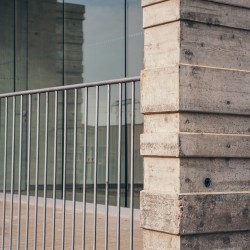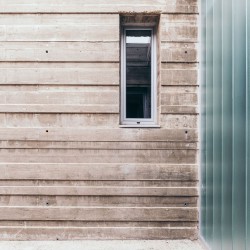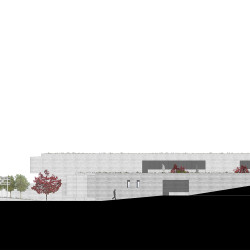studioVRA . photos: © Javier Bravo Fotografía
The new Day Care Center for People with Alzheimer’s Disease in Benavente (Zamora, Spain) arises from the aging of the region’s population. When designed, there was no proven scheme for this typology, despite the growth of the disease in recent years in some regions of the country. Hence, the initial program only specified for the inclusion of spaces for cognitive and physical stimulation activities, with dining and rest area for fifty users. Therefore, the first task was to understand the logic of this typology and crystallize it into an architectural scheme.Another important starting point was the location of the Center within a double boundary situation (territorial and urban). On the one hand, the town is located on the periphery of the great Castilian plateau, so it is endowed with a particular topography: between hills, valleys and plains, with a historic condition of crossing roads, and some of the main arterial roads of the country. On the other hand, the plot is also located within a municipal boundary area, on a hill with a steep slope between an expansion area and farmland. This situation emphasizes again the conjunction of landscapes in the building.
All of these ideas motivated the positioning of the building in the upper part of the plot, in order to facilitate a stratum of it to rotate and tear the slope to create a new plain area. Then, in a second movement, part of that stratum rises another level vertically to protect the building on its urban front. Thus, a new line of the horizon is created, a main subject of the building, which not only symbolizes the synergy of the community in the face of this disease, but also dialogues with the landscape.
Once on the surface, the emerging stratum is excavated to house the different spaces. These are divided into four zones according to their degrees of privacy and use. On the one hand, two large retaining walls extend outwards to mark the entrance and separate the public spaces (differentiated as administrative and multipurpose areas) from the private ones. While the latter are articulated around two corridors of great width, their diversity assists in spatially orienting visitors. These spaces are conceived as the most important “rooms” with therapeutic functioning in the Center. From each of them, the rest of the private spaces can be accessed. One provides access to the most frequently used rooms (classrooms, geriatric bathrooms, courtyards), and the other to the lesser-used spaces (dining area, rest area). All of them are designed according to the specific needs of people with Alzheimer’s disease. Thus, it is designed with a clear and resounding scheme that optimizes the operation of the building, allowing for simple, simultaneous and independent use of the different areas, and a maximized use of its energy resources.
Inside the building, a great significance is given to the design elements that help to qualify the space and make it more recognizable and comfortable for the user. For example, the continuity of the railings in the corridors, the courtyards (classrooms) that allow inhabitants to engage in activities while in clean air and natural lighting, or the use of materials that improve the comfort of the user and the use of the Center. In this sense, the classrooms gain importance for their position, and for their use of the large windows that connect the excavated space to the landscape.
The rest of the plot (developing in a second phase) is a large two-level garden. However, both are conceived together due to their common conceptual origin, and the upper garden extends itself over the green roof and water storage. Hence, the building is related to the landscape both formally and materially. This area is conceived as the largest room in the Center, as it encourages outdoor activities, and assures users direct contact with the outside and the landscape of their memory.
_
DAY CARE CENTER FOR PEOPLE WITH ALZHEIMER’S DISEASE IN BENAVENTE (SPAIN
studioVRA (Rubén García Rubio & Sonsoles Vela Navarro)
CLASSIFICATION Civic Building – Health Care Center
PROJECT Day Care Center for People with Alzheimer’s Disease
LOCATION Calle Baños de Montemayor 10b
Benavente (Zamora, Spain)
DATE Project 2008-09
Construction 2010-17
DEVELOPER Asociación de Familiares y Enfermos de Alzheimer de Benavente y Comarca
Junta de Castilla y León
AWARDS 1º Prize “Invited Competition (2009)”
Award “20+10+X Architecture Awards 8th Cycle (2010)”
Honorable Mention “III Sustainable Construction Awards Castile and Leon (2010)”
Shortlisted “Endesa Awards Most Sustainable Property Development – No Residential- (2012)”
Shortlisted in the Emerging Architects Forum in Spain “Arquia Proxima 2017-18 – Relevant Practices” (2018)
Selected “German Design Awards’19” (2018)
Honorable Mention “SARCH Architecture Award 2018” (2018)
Award “10th Architecture and Urban Planning Awards of Castile and Leon” (2018)
CREDITS
AREA 1470 m2 (Built Area) + 2999 m2 (Outdoor Area)
BUDGET 1.695.296, 94 €
ARCHITECTS studioVRA
Rubén García Rubio & Sonsoles Vela Navarro
studioVRA.com
COLLABORATORS Enrique Juanes, Architect (Scheme and Detail Design + Structure)
Miguel Martínez Monedero, Architect (Scheme Design)
SURVEYORS Rocío Movilla Gangoso
Rubén de Dios Andrés
CONTRACTOR Huerga Roman SL (until structure)
Construcciones P. Sánchez Rodríguez SL
STRUCTURE Rubiera – Jorge Pellitero Vázquez, Civil Engineer
MECHANICAL SYSTEMS Ventilating and Air Condition Systems: Clima-Dur SL
Heating and Water Systems: Empresarial Saneamientos Cortes SL
Electrical Systems: Taller Eléctrico Casa SL
Fire Protection Systems: SIMI Seguridad SL
CARPENTRY Aluminios Cortizo SA
LIGHTING Taller Eléctrico Casa SL -Irelux
PHOTOGRAPHS Javier Bravo Fotografía
Rubén García Rubio (VRa)
El nuevo Centro de día para en enfermos de Alzheimer de Benavente (Zamora) surge ante el creciente envejecimiento que sufre la población en su comarca. En el momento del diseño todavía no existía ningún esquema probado que estructurase esta tipología, aunque dicho crecimiento había sido progresivo en los últimos años en muchas regiones del país, de ahí que el programa inicial solo especificase la inclusión de espacios para la estimulación cognitiva y física y áreas para comer y reposar para 50 usuarios. Por ello, la primera tarea fue comprender el funcionamiento de esta tipología y cristalizarlo en un esquema arquitectónico. Otra característica importante de partida fue la ubicación del Centro dentro en una doble situación limítrofe (territorial y urbana). Por un lado, la localidad se ubica en la periferia de la gran meseta castellana por lo que está dotada de una topografía particular, entre lomas, valles y planicies, y una histórica condición de cruce de caminos, con la distribución de algunas de las principales arterias del país. A su vez, la parcela también se sitúa en un lugar limítrofe dentro del municipio, en una loma con cierta pendiente entre una zona de expansión y tierras de cultivo, lo que enfatiza nuevamente la conjunción de paisajes en el edificio. Todo ello motivó el posicionamiento del edificio en la parte superior de la parcela para facilitar que un estrato de la misma pudiese girar rasgando la pendiente hasta crear una nueva planicie. Posteriormente, en un segundo movimiento, parte de dicho estrato se eleva verticalmente una planta para proteger al edificio en su frente urbano. De esta forma se crea una nueva línea de horizonte, verdadera protagonista del proyecto, que simbolizaba la sinergia de la comunidad frente a esta enfermedad a la vez que dialoga con el paisaje. Una vez en la superficie, el estrato emergente se excava para albergar los diferentes espacios que se dividen en cuatro zonas según sus niveles de privacidad y uso. Por un lado, dos grandes muros de contención se extienden hacia el exterior para marcar la entrada y separar los espacios públicos (diferenciados a su vez en administrativo y salas polivalentes) de los privados. Mientras que estos últimos se articulan alrededor de dos pasillos de gran anchura, aunque diversa para caracterizarlos y fomentar la orientación, concebidos como las estancias más importantes dentro del funcionamiento terapéutico del Centro. A partir de cada uno de ellos se accede al resto de espacios privados, uno da acceso a las estancias de uso frecuentes (aulas, baños geriátricos, patios-estancias…) y el otro a los espacios ocasionales (sala de estar, comedor…). Todos ellos proyectados según las necesidades específicas de personas con la enfermedad de Alzheimer. Así se desarrolla un esquema claro y rotundo que optimiza el funcionamiento del edificio, permitiendo el uso simultáneo, sencillo e independiente de las diferentes zonas, y el aprovechamiento de sus recursos energéticos En el interior adquieren gran importancia aquellos elementos que ayudan a cualificar el espacio y hacerlo más reconocible y cómodo para el paciente, como pueden ser la continuidad de la línea de barandillas en los pasillos, los patios-aulas que permiten desarrollar actividades en el exterior a la vez que obtener ventilación e iluminación natural o el uso de materiales que mejoran el confort del usuario y la utilización del Centro. En este sentido, las aulas cobran un valor especial tanto por su disposición espacial como por la utilización de los grandes ventanales que conectan el espacio excavado con el horizonte lejano. El resto de la parcela (desarrollándose en una segunda fase) es un gran jardín de dos niveles. No obstante, ambos están concebidos conjuntamente, incluso la parte superior se extiende sobre la cubierta-aljibe, debido a su común origen conceptual. De esta forma el edificio se relaciona con el paisaje tanto formal como materialmente. Pero, sobre todo, esta zona se concibe como la estancia más grande del Centro ya que en ella se fomentan las actividades al aire libre, lo que garantiza a los usuarios el contacto directo con el exterior y el paisaje de su memoria.












































